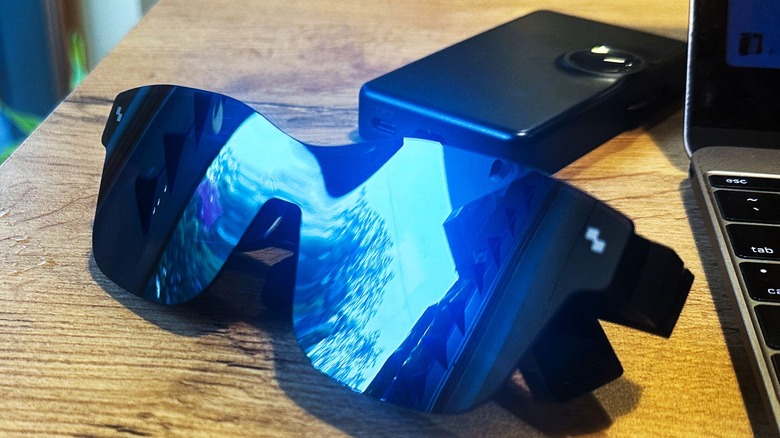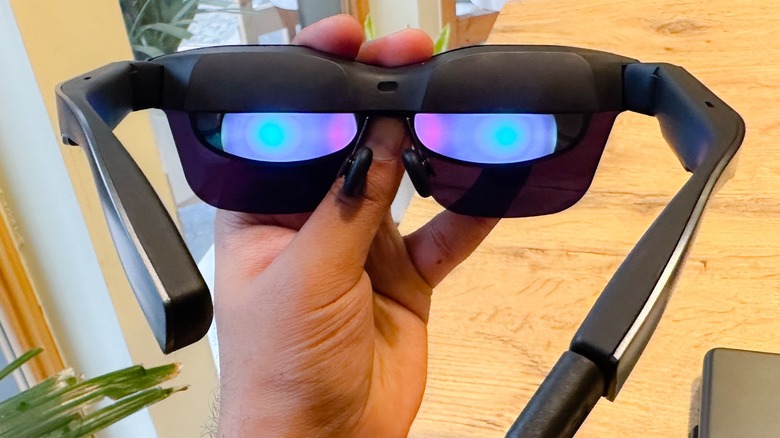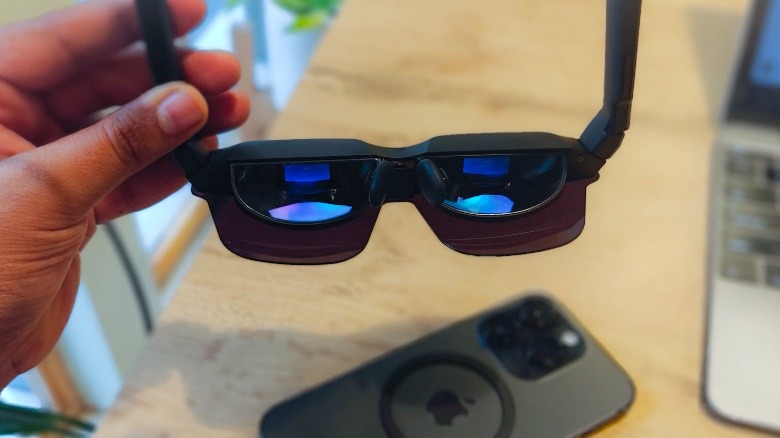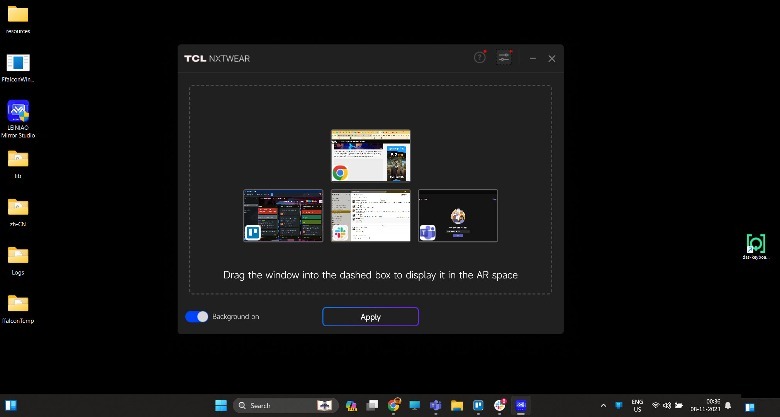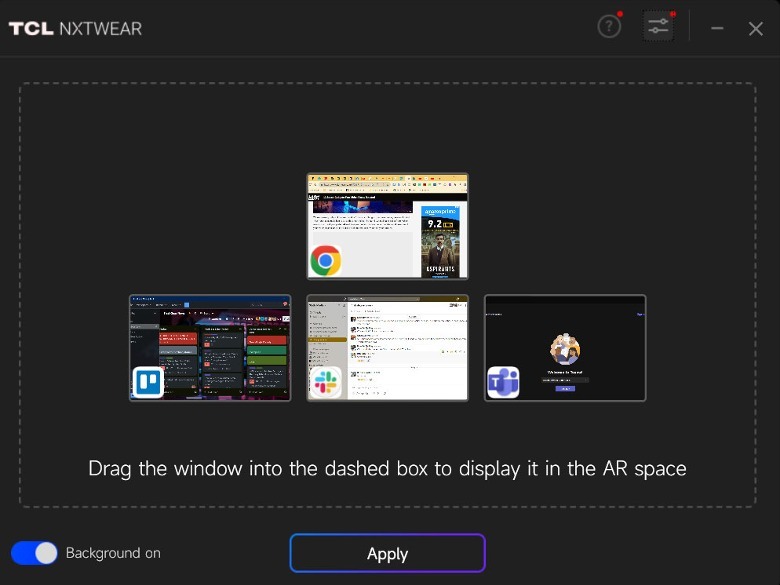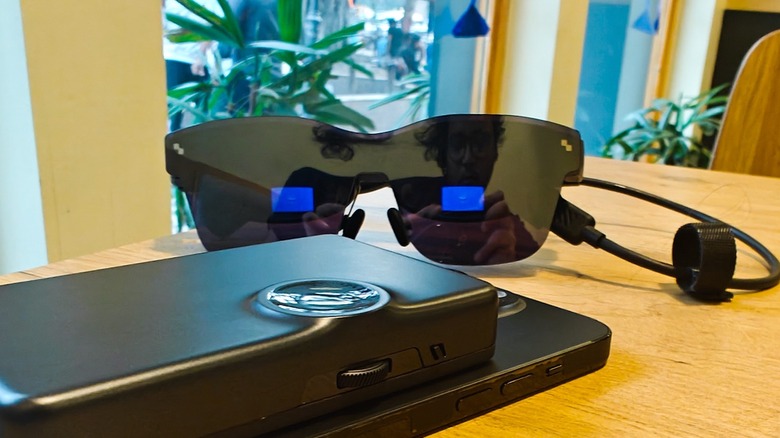RayNeo Air 2 Review: XR Smart Glasses Have The Look, But At What Price?
- Sharp design for niche XR hardware
- Bright and well-saturated display
- Loud speakers with whisper mode facility
- Spatial computing is a promising start
- Peripheral blurring issue in virtual windows
- Desktop software and app need more work
- Speaker won’t take call for some reason
- The Lightning situation on iPhones is cluttered
We may receive a commission on purchases made from links.
TCL has been experimenting with AR glasses for a while now under the NXTWEAR branding. Recently, it branched out its wearable efforts under the RayNeo label, which is now trying to make a splash with a new pair of flashy AR glasses (here in 2023). Dubbed the RayNeo Air 2, these go against the likes of Xreal Air 2, the Rokid Air series, and the Viture One — not to mention Lenovo's Legion Glasses.
RayNeo hasn't cut any corners in making its latest pair of AR Glasses, paying special attention to the design. In fact, these are the best-looking AR glasses in the market if you want to steer clear of the overdone Wayfarer look. The OLED display units have also been upgraded and they are now brighter than what the competition can muster. The lighter frame and native support for high-refresh-rate content are also welcome refinements.
Overall, the RayNeo Air 2 comes out as a meaningful iterative update over TCL's previous attempts in areas that matter the most. But not everything is perfect here, as the team behind Air 2 apparently reserved all their focus for the hardware. If you've got around $400 to spare for gadget experimentation and the latest RayNeo AR glasses are on your radar, read on to find where they excel and the aspects they underperform.
A standout design for XR hardware
Aesthetics is one area that will win the RayNeo Air 2 many converts. It ditches the nerdy prescription glasses look of its NXTWEAR siblings and also steers clear of the Ray-Ban look that every other brand is busy aping. RayNeo has gone with a frame-less approach for the front side. Imagine Wellington sunglasses, but remove the rim and give them a sporty touch with a reflective mirror finish on top.
From the front, it's hard to discern them from a regular pair of chrome-tinted sunglasses. The only giveaway is that they sit a bit further from the eyes and much lower on the nose than regular eyewear. But that's a necessary evil for almost every other product in the segment.
The side profile is a bit thicker, but compared to the thick stem and exaggerated curved tail on the NXTWEAR series glasses, the RayNeo Air 2 does a far better job of hiding its tech credentials. The only issue is that the nose clip is a bit tight and uncomfortable, especially if you plan to wear it for lengthy sessions. Thankfully, the steam is adjustable across two axes for a comfortable fit.
RayNeo, however, serves a thoughtful convenience inside the box in the form of a magnetic clip and prescription lens insert dummies. The glasses are comfortable to wear with these inserts, and there is no weird alignment or distortion to be seen for on-screen content.
A bright and beautiful display
The display is a Sony-made micro-OLED panel with an effective resolution of 1920 by 1080 pixels per eye, which is fairly standard across the industry. The field of view figures stands at 46 degrees, which is once again a norm for the segment but falls short of the 49 degrees FOV offered by Xreal's latest glasses.
Where RayNeo stands above its direct competitor is the brightness output. The display units can go up to 600 nits, which is better than what rivals from Xreal and Rokid have to offer, but far below the Viture One's 1,800 nits brightness. The viewing experience on the RayNeo Air 2 is satisfying, especially at a 120Hz refresh rate.
The virtual screen, which spans 201 inches with a relative distance of just under 20 feet (6 meters) from the eyes, is bright and vivid. Color saturation is pleasing and there is no shimmering issue to be seen here. Even under daylight, the virtual screen is legible at peak brightness and you won't need to move elsewhere due to visibility issues.
If you are planning to use the. RayNeo Air 2 for media consumption, you won't be left wanting for more. The mirrored finish on the outer glass does a good job of blocking external light, keeping optical interference in check to a healthy extent. However, it would've been nice if RayNeo shipped an external glass cover, the way Xreal does, to achieve maximum immersion against a pitch-dark backdrop.
A few display snags
RayNeo has armed the Air 2 with a decent quality display unit, but when it comes to AR glasses, hardware is only half the picture. The latter proves to be a sore omission on RayNeo's latest offering. But let's start with the basics. While watching video content, the virtual display does its job well, offering an even brightness output with uniform color distribution across the entire canvas. The same goodness extends to playing games, either mirrored from a phone or while plugged into a PC.
But when the display is tasked with activities such as web browsing or reading content, there is a noticeable ghosting alongside the vertical edges and the corners. Text appears sharp and well-lit in the center, but as you approach the corner areas, legibility worsens and it becomes hard to read text in those regions. Initially, it seemed like an issue for people with myopic or hyperopic eye conditions.
However, we asked nearly a dozen folks — with perfect vision and wearing prescription glasses — to try the RayNeo Air 2, and they also confirmed the clarity problem. Replacing glasses with prescription contact lenses reduced it, but not in its entirety. TCL tells SlashGear that users should experiment with adjusting the nose clip arms and play with the nose pad to solve the aforementioned problem. We removed the nose clip entirely to get the best ocular position and saw some improvements, but the problem persisted when using multiple virtual windows side-by-side.
Platform support is diverse, but needs more polish
The RayNeo Air 2 follows a plug-and-play format, at least for mirroring content on mobile devices as well as gaming handhelds such as the Steam Deck and Nintendo Switch (with a standalone dock for the Switch coming later). Aside from Android and iOS, devices that have a USB-C outlet with DisplayPort support play well with the glasses. Even with outlier platforms such as ChromeOS and iPadOS, plugging them via a USB-C cable instantly served a large virtual screen in extended display mode.
However, the iOS situation is a bit tricky. To start, the companion app kept running into a Bluetooth error. Next, you need a Mirascreen casting hub that plugs directly into the iPhone's Lightning port while the other USB-C outlet is linked to the glasses. The retail package comes with a magnetic ring that is glued to the back of an iPhone, while the casting hub attaches magnetically above it.
The situation was identical on the Xreal Air 2 with the beam accessory, but then, the Beam had a dramatically better build quality and offered a healthy bunch of its own AR perks. Another issue is that there is no option to calibrate the laser pointer to your head movement, and the cursor movement on the desktop is also slightly off. Furthermore, neither the desktop nor mobile app shows an on-screen virtual keyboard. You need to turn back to your phone's screen or laptop for typing.
A handful of software quirks
Despite serving solid hardware, RayNeo Air 2 fails to impress at software-side niceties. Compared to the Nebula app shipped by Xreal, the Rayneo XR companion app is nigh barren in terms of controls. Disappointingly, the feature gap is huge. The Nebula app for Xreal Air lets you lock the virtual display at a particular position in the air relative to the head alignment and also offers the flexibility to move it with your head adjustments. There's also a third mode where the virtual screen is locked to one quadrant, allowing users to see the world around them with ease.
But there's another fundamental facility that RayNeo has omitted, and that's the ability to adjust the relative distance and size of the virtual screen. Xreal's execution is extremely rewarding, even though there's a slight learning curve in mastering the laser pointer movements. The RayNeo Air 2 doesn't offer any of those facilities. Instead, it comes out predominantly as a large secondary screen that sits right in front of your eyes in a Wayfarer-like chassis.
The app lacks even the most fundamental spatial adjustment controls. Another flaw is the virtual screen, which despite supporting 3DoF (Degree of Freedom) head movement, tends to cut off parts of the visual experience alongside the bottom edge, which means you have to move your head to see those controls in a horizontal deck. Finally, the AR experiences are limited to smartphones, while floating window computing is restricted to Windows.
A great display robbed of AR experiences
The RayNeo XR app offers a large AR canvas within a curved surround-view format. The homepage of the RayNeo XR app, which is available on Android as well as iOS, hosts quick controls like volume and eye protection mode on the left, while calendar and clock information both sit on the right. At the center is the dashboard where you get three categories of pre-built content.
The first one is "Panorama World," a selection of panoramic videos and photos of different cities and landscapes across the world. The "Art Experience" segment is populated by interactive, abstract art pieces in a 3D space that changes shape and produces effects on interaction with the laser pointer. Then there is "Sketch Fab," a selection of incredibly detailed photographic pieces that you can peek at from any angle across three axes.
There's also a selection of 15 games, but most of them simply refused to launch. Those that we could open had issues with touch input — or the laser pointer simply didn't work. There isn't an option to download additional AR apps, so what you're left with are mostly one-time vanity 3D indulgences that you will never return to again.
Powerful spatial computing that needs refinements
Now, this is where things get interesting. Where Xreal has decided to focus on macOS for spatial computing, TCL has limited the RayNeo Air 2 to Windows. The experience of running multiple floating app windows comes to life courtesy of the TCL NXTWEAR Mirror Studio. But unlike Xreal's Nebula, the TCL app first needs you to pinch an app's window and drag it into a cluster inside the NXTWEAR Mirror Studio app, and only then do they appear on the RayNeo Air 2 screen.
You can run up to six apps at a time, but the window size gets too small for comfortably viewing content. You can choose to align the windows on a curved canvas or turn them flat. Angle and size controls are available, but they are quite janky, and getting the right alignment is a chore. Sticking with the default size and angle presets is the way to go. Another disappointment is the lack of any screen recording or capture option in the app.
But the worst part is the peripheral blurring, which makes the content appear fuzzy alongside the top corners especially. You really have to move your head all the way to the left or right and put a centered focus on the blurry area to see it clearly. There is no display shimmer effect, thankfully, and centered content is sharp, but there is some jitter when glancing between windows. Reducing the head movement sensitivity helps here.
A good-bad speaker situation
The speakers on RayNeo Air 2 are fairly loud. They produce sound that is good enough for watching videos and listening to music. Even at high volume levels, they didn't crush the vocals or lead to any jarring distortion. Just don't expect them to deliver any kind of bass or smooth trebles. They are also sufficiently loud, and at peak levels, you can feel the sound vibrations in the chamber of the glasses' stem.
At peak volume, a person sitting beside you can faintly hear what's playing on the speakers, assuming the surroundings are not noisy. But if you can keep the volume levels around the 70% levels, the audio output is fairly discrete. There is also a dedicated Whisper Mode for extra privacy. It lowers the loudness levels and shrinks the sound stage to make the audio output seem more directional, instead of a surround-sound approach.
Oddly, these in-built speakers on the RayNeo Air 2 won't take calls. Direct carrier calls as well as those facilitated by apps such as WhatsApp instantly switch to the phone speakers, instead of routing them through the onboard speakers. If you have Bluetooth earbuds plugged in, it's all good and fine. It might sound like a privacy-centric choice on behalf of RayNeo, but it's odd when the smart glasses offered by Amazon (Amazon's Echo Frames) and Razer (Razer Anzu) have no problem letting you take calls.
Verdict
The RayNeo Air 2 smart glasses get the design part right to a large extent. It would ultimately boil down to personal preference whether you fancy the wayfarer look or a sporty mirror finish. The build quality is fantastic here and they are comfortable to wear. The screen is pleasingly bright and vivid. Support for a 120Hz refresh rate is good to have and head tracking is on-point, as well. RayNeo thoughtfully ships lens inserts in the box and has partnered with Lensology in the U.S. to provide prescription lenses.
Where the latest RayNeo glasses falter is the odd peripheral fuzziness issue on the screen, inadequate selection of pointer and virtual window controls, and lack of meaningful AR experiences. Xreal at least throws fitness and health-centric AR experiences into the mix, even though it doesn't fare much better at app diversity, either.
The RayNeo Air 2 has all the material at its disposal to succeed, but the team needs to work on the software situation, especially the spatial computing situation on Windows. And hopefully, replicate the same on macOS. It's hard to tell when, or if, that is going to happen.
In its current state, it's tricky to recommend the RayNeo Air 2 listed at $379 on Amazon, when the Xreal Air 2 offers a noticeably more refined experience for just $20 more. But if your eyes are fixated on the RayNeo Air 2's cool looks and all you need is a virtual screen for video watching, these glasses won't disappoint.

